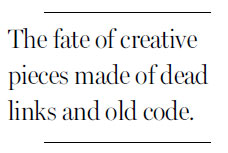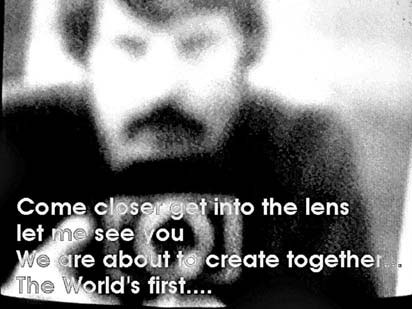Aging Digital Artworks Are difficult to restore
Updated: 2013-06-30 07:37
By Melena Ryzik(The New York Times)
|
|||||||||
|
New technologies threaten digital art. An image from "The World's First Collaborative Sentence," by Douglas Davis. Lehman College Art Gallery |

Paintings fade; sculptures chip. Art restorers have long known how to repair those material flaws. But when a Web-based work becomes technologically obsolete, does updated software simply restore it? Or is the piece fundamentally changed?
That was the conundrum facing the Whitney Museum of American Art in New York, which in 1995 became one of the first institutions to acquire an Internet-made artwork. Created by the artist Douglas Davis, "The World's First Collaborative Sentence" functioned as blog comments do, allowing users to add to its opening lines. The piece attracted 200,000 contributions worldwide from 1994 to 2000.
By 2005 it had changed computer servers, and the programmer moved on. But when Whitney curators decided to resurrect the piece last year, the art didn't work. Once innovative, "The World's First Collaborative Sentence" now mostly just crashed browsers with its rudimentary code and out-of-date links.
In trying to restore the Davis work, which was finally achieved at the end of May, the Whitney encountered a challenge unique to digital art: its 1s and 0s degrade far more rapidly than traditional visual art does, and the demands of upkeep are much higher.
"We're working on constantly shifting grounds," said Rudolf Frieling, a curator of media arts at the San Francisco Museum of Modern Art, which has been at the forefront of sustaining online art. "Whatever hardware, platform or device we're using is not going to be there tomorrow."
At the Whitney, a team of programmers and curators spent more than a year debating and tinkering with the restoration. Mr. Davis, now 80, could not consult on rebuilding his piece.
"One of the biggest philosophical questions," said Christiane Paul, adjunct curator of new media at the museum, "was, do we leave these links broken, as a testament to the Web" and its rapid development?
"Collaborative Sentence" is still valuable, Ms. Paul said, especially as a harbinger of the future. By allowing interaction across cultures and countries, "it anticipated so much of what happened in Web 2.0," she said.
Many artists, curators and patrons are now reconsidering whether such art should remain unchanged, said Pip Laurenson, the head of collection care research at the Tate Gallery in London. "It's no longer the model that a museum acquires something into its collection and tries to fix it into the time it was acquired or when it left the artist's studio."
After much deliberation, the curators decided on a nearly unheard-of solution: to duplicate Mr. Davis's installation and present it in both original and updated forms.
One version is the frozen original, with broken code and instructions for users who wanted to fax in their contributions.
"The idea is that it's sort of a time capsule," said Ben Fino-Radin, a digital archivist who helped rebuild the work.
The new version, which the Whitney calls the live version, looks similar but has some new links. Users can't contribute to the historical site, but they can add to the live one - albeit not by fax. The Whitney also open-sourced part of the original, hoping that users would contribute to its upkeep.
In 1995 Mr. Davis's piece was shown in a biennial in South Korea attended by the celebrated video artist Nam June Paik. It has hundreds of comments in Korean, but the code for the characters was so degraded that Mr. Fino-Radin was stumped. If other viewers fix it, he said, seeing those messages "will be a first for Western audiences."
Over the past decade, experts at the New Art Trust, the Tate Modern in London and the Museums of Modern Art in New York and San Francisco started Matters in Media Art, a consortium dedicated to studying the issue of digital art becoming obsolete.
"For institutions that early on committed to Net art, a lot of that work is now vanishing," Ms. Paul said.
And the proliferation of online culture and whatever the next tech revolution brings will make preserving those visionary moments "more challenging," she said. "Not less."
The New York Times
(China Daily 06/30/2013 page12)
